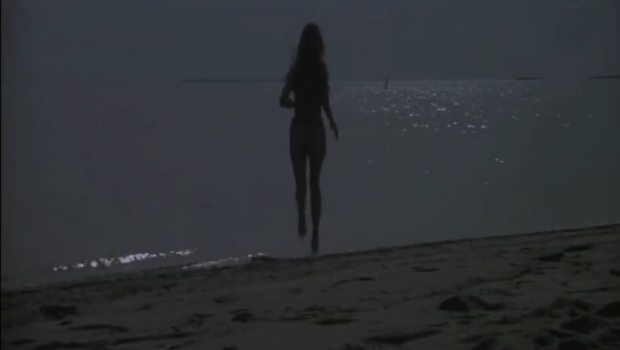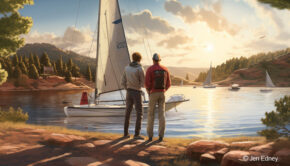The day I showed ‘Jaws’ at sailing camp
Published on July 30th, 2015
by Charlotte Wilder, Boston.com
I can’t remember whose idea it was to do so, but I can remember inserting the VHS into the VCR, so I’m afraid it might’ve been mine.
It was the summer of 2006, and sheets of rain beat against the windows of the Rockport Boat Club, a small shack next to the fishing docks in Rockport, Maine. We’d heard the announcement of a small craft advisory fight its way through the static of the marine radio, so I and the other instructors decided there would be no sailing that day. And on days we couldn’t sail, we showed our young students movies.
This time, we picked Jaws.
My grandfather died in 1990. Twelve years later, when I started going to sailing camp there, his photograph was still pinned to the “new members” bulletin board. The drawings on posterboard illustrating the points of sail were all but invisible, faded from years of sun and warped by salty humidity. We still used a VCR in 2006.
Rockport was not where you learned to sail if you wanted to be really good at sailing. Parents who hoped their children would someday be able to hobnob with the partners on teak decks in the Hamptons sent their children to sailing camp at the Camden Yacht Club. There, they had a full kitchen with lunch service that you could charge to your family’s tab, locker rooms, a mahogany-panelled ballroom, and boats that weren’t held together with bungie cords. There wasn’t a piece of duct tape in sight.
At Rockport, we had one room and the floor was made of linoleum masquerading as hardwood. There was a kitchen, but it was just one wall cordoned off by a counter. Fly swatters comprised most of the utensils in the drawers, and fly paper permanently hung from the rafters, a vertical graveyard of bugs. On days when the wind came from the south—most days in June and July—the smell of the mackerel that lobstermen used as bait would float over from the dock next to us, mingling with the taste of sandwiches as we ate our homemade lunches outside.
We took pride in not being Camden. We were the wild ones, the outlaws of the mid-coast sailing clubs. When I sailed at Rockport as a student, we’d capsize the boats on purpose and dance on top of their upside-down hulls. We’d tie our dinghies up to the large bell anchored over a mile away from shore, climbing up the 20 foot-high tower and leaping off into the waves. We made slingshots out of sticks and shot rocks at each other.
Our instructors were gods. They were tanned and bleached from the sun, they blasted music from their motor boats, and they let us get away with anything that didn’t seem imminently life-threatening. Even then, we had some scares. Most of us came close to drowning, and hypothermia occasionally set in. Someone got run over by a motor boat and the propeller barely missed his head.
Fear is essential when you’re spending time on the water. You have to be half-terrified most of the time so that you’re aware and alert enough when everything suddenly falls apart, because it always does. Fog rolls in so thick that you can’t see your own hands in front of your face. The mast of your boat snaps in half. The rudder cracks and you lose all ability to steer. You capsize and slice your leg open miles away from shore.
But if you feel the magnetic pull to the water, none of this can scare you away.
I eventually outgrew the lifejacket I’d worn as a student, and I and some of the kids I grew up sailing with got hired to be instructors ourselves. We became the ones we’d once so revered, launching water balloons at young sailors and driving by their boats in our launches, leaving huge waves and gleeful shrieks in our wake.
We kept our damp and smelly sails, barnacle-covered buoys, spare anchors, and rainy-day games in a narrow walk-in closet at the back of the boat club. There, in a cabinet behind the huge, boxy television, were three videotapes: Muppet Treasure Island, Andre (a movie about a seal based on a true story that took place in Rockport), and Jaws.
It had been a rainy July that year, so the kids had already seen Muppet Treasure Island and Andre at least four times each. We’d also exhausted all the indoor games we had, and taught our young sailors how to tie more knots than even Captain Ahab himself would’ve needed to know.
Those are probably the reasons that I found myself popping Jaws into the VCR and fast-forwarding through the previews the came before the opening scene. But I suspect we instructors also wanted to see how far we could go in thrilling the small people who revered us.
As the camera panned across the dunes and the ominous music accompanied Chrissie’s running and then swimming figure, I noticed some of the kids, all of whom were around 11 or 12 years old, starting to squirm. I also noticed that both Chrissie and the man with her are drunk in the opening scene, and that you can see her naked profile for a moment. Even I, a 16-year-old wrestling with her first shot at responsibility, sensed that something was off.
I paused the tape, but the kids protested. They said they could handle it, and begged me to let the movie play. I looked at the other instructors, who shrugged and echoed the kids.
I realize now that the students were probably just trying to impress the only authority figure in their lives who didn’t make them eat their vegetables or assign them homework. I also realize that I and the other instructors conflated responsibility with the identities we wanted for ourselves. We used the kids to push boundaries and prove our own toughness when instead, we should’ve pressed eject.
I pressed play.
As the ominous music grew louder and the camera shifted up towards Chrissie’s naked figure in the water, I could feel my own heart pounding.
And then she starts getting eaten. “Help me, Help me!” she cries.
The kids’ knuckles grew white as they clutched the sides of their canvas chairs. There were a few gasps and some yelps.
The actress’s cries of “Oh God, oh God!” and “It hurts, it hurts!” filled the room. Then she got dragged under, and the boat club, along with the movie, went silent.
One young sailor looked close to tears. A few turned and looked at me, eyes wide with terror.
“We don’t have any sharks in Rockport,” I said, leaping up to pause the tape again. My face flushed with embarrassment. “That won’t happen here.”
“Please don’t tell your parents,” I added.
For the next week, none of the kids would swim, and they wouldn’t sail out farther than the inner harbor. It took all of us instructors getting in the water and spending at least 15 minutes in the freezing cold Maine ocean without getting eaten to convince them that they were safe. Or at least safe from sharks.
The week after that, when normal sailing activities had resumed, one of the kids got hit in the head with the boom of the sailboat, a large metal piece that holds the mainsail and swings back and forth across the boat when it switches directions. He bled profusely and fell into the water, where we quickly scooped him up in one of our motor boats.
He was a trooper about it, remaining brave and even cracking a few jokes as I held gauze to his head while we waited for his mother to arrive and accompany us to the emergency room.
“I’m just glad the blood didn’t attract any sharks,” one of the other sailors said.
So was I. We had enough to worry about without them.
Source: Boston.com









 We’ll keep your information safe.
We’ll keep your information safe.